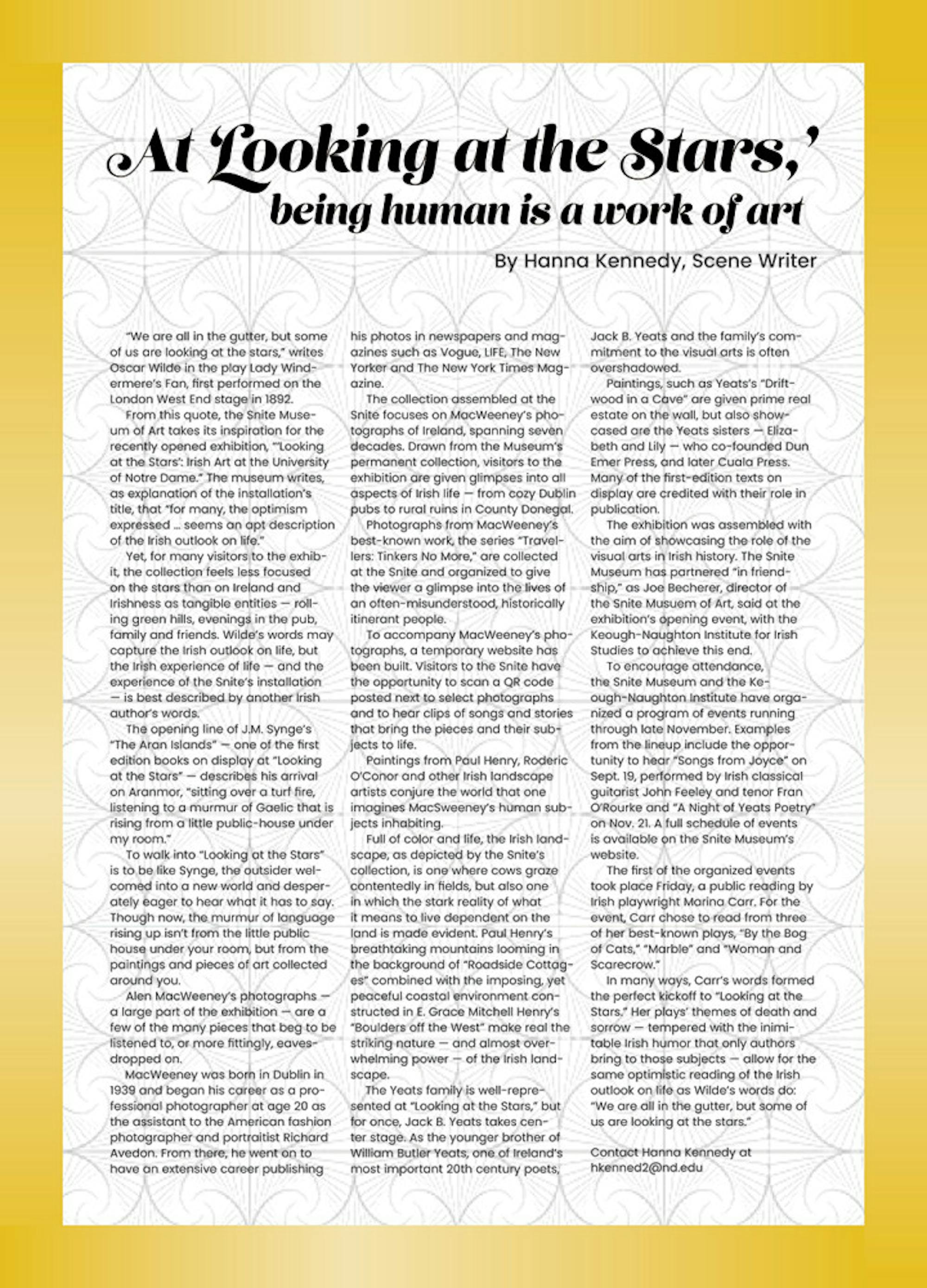
“We are all in the gutter, but some of us are looking at the stars,” writes Oscar Wilde in the play Lady Windermere’s Fan, first performed on the London West End stage in 1892.
From this quote, the Snite Museum of Art takes its inspiration for the recently opened exhibition, “‘Looking at the Stars’: Irish Art at the University of Notre Dame.” The museum writes, as explanation of the installation’s title, that “for many, the optimism expressed … seems an apt description of the Irish outlook on life.”
Yet, for many visitors to the exhibit, the collection feels less focused on the stars than on Ireland and Irishness as tangible entities — rolling green hills, evenings in the pub, family and friends. Wilde’s words may capture the Irish outlook on life, but the Irish experience of life — and the experience of the Snite’s installation — is best described by another Irish author’s words.
The opening line of J.M. Synge’s “The Aran Islands” — one of the first edition books on display at “Looking at the Stars” — describes his arrival on Aranmor, “sitting over a turf fire, listening to a murmur of Gaelic that is rising from a little public-house under my room.”
To walk into “Looking at the Stars” is to be like Synge, the outsider welcomed into a new world and desperately eager to hear what it has to say. Though now, the murmur of language rising up isn’t from the little public house under your room, but from the paintings and pieces of art collected around you.
Alen MacWeeney’s photographs — a large part of the exhibition — are a few of the many pieces that beg to be listened to, or more fittingly, eavesdropped on.
MacWeeney was born in Dublin in 1939 and began his career as a professional photographer at age 20 as the assistant to the American fashion photographer and portraitist Richard Avedon. From there, he went on to have an extensive career publishing his photos in newspapers and magazines such as Vogue, LIFE, The New Yorker and The New York Times Magazine.
The collection assembled at the Snite focuses on MacWeeney’s photographs of Ireland, spanning seven decades. Drawn from the Museum’s permanent collection, visitors to the exhibition are given glimpses into all aspects of Irish life — from cozy Dublin pubs to rural ruins in County Donegal.
Photographs from MacWeeney’s best-known work, the series “Travellers: Tinkers No More,” are collected at the Snite and organized to give the viewer a glimpse into the lives of an often-misunderstood, historically itinerant people.
To accompany MacWeeney’s photographs, a temporary website has been built. Visitors to the Snite have the opportunity to scan a QR code posted next to select photographs and to hear clips of songs and stories that bring the pieces and their subjects to life.
Paintings from Paul Henry, Roderic O’Conor and other Irish landscape artists conjure the world that one imagines MacSweeney’s human subjects inhabiting.
Full of color and life, the Irish landscape, as depicted by the Snite’s collection, is one where cows graze contentedly in fields, but also one in which the stark reality of what it means to live dependent on the land is made evident. Paul Henry’s breathtaking mountains looming in the background of “Roadside Cottages” combined with the imposing, yet peaceful coastal environment constructed in E. Grace Mitchell Henry’s “Boulders off the West” make real the striking nature — and almost overwhelming power — of the Irish landscape.
The Yeats family is well-represented at “Looking at the Stars,” but for once, Jack B. Yeats takes center stage. As the younger brother of William Butler Yeats, one of Ireland’s most important 20th century poets, Jack B. Yeats and the family’s commitment to the visual arts is often overshadowed.
Paintings, such as Yeats’s “Driftwood in a Cave” are given prime real estate on the wall, but also showcased are the Yeats sisters — Elizabeth and Lily — who co-founded Dun Emer Press, and later Cuala Press. Many of the first-edition texts on display are credited with their role in publication.
The exhibition was assembled with the aim of showcasing the role of the visual arts in Irish history. The Snite Museum has partnered “in friendship,” as Joe Becherer, director of the Snite Musuem of Art, said at the exhibition’s opening event, with the Keough-Naughton Institute for Irish Studies to achieve this end.
To encourage attendance, the Snite Museum and the Keough-Naughton Institute have organized a program of events running through late November. Examples from the lineup include the opportunity to hear “Songs from Joyce” on Sept. 19, performed by Irish classical guitarist John Feeley and tenor Fran O’Rourke and “A Night of Yeats Poetry” on Nov. 21. A full schedule of events is available on the Snite Museum’s website.
The first of the organized events took place Friday, a public reading by Irish playwright Marina Carr. For the event, Carr chose to read from three of her best-known plays, “By the Bog of Cats,” “Marble” and “Woman and Scarecrow.”
In many ways, Carr’s words formed the perfect kickoff to “Looking at the Stars.” Her plays’ themes of death and sorrow — tempered with the inimitable Irish humor that only authors bring to those subjects — allow for the same optimistic reading of the Irish outlook on life as Wilde’s words do: “We are all in the gutter, but some of us are looking at the stars.”
Read More
Trending









